
Knowledge Hub
“We had to leave. We left our house open because we were losing everything anyway. We didn’t have time for food and we didn’t even dress the children.” Jaheda*, 30, mother of four.
Two years since they fled Myanmar’s Rakhine State for neighbouring Bangladesh, we take a look back at a crisis that has seen close to 700,000 Rohingya cross the border into Cox’s Bazar, a former holiday destination on the country’s south-eastern coast.
Jaheda is one of over 1.2m people – including members of the local community and those refugees who had fled to Cox’s Bazar before the events of August 2017 – currently in need of humanitarian assistance and doing their best to navigate life in the world’s biggest refugee camp.
Background of the crisis
The Rohingya people represented the largest group of Muslims living in Myanmar at the start of 2017, with the vast majority of more than one million resident in Rakhine State.
Regarded as ‘stateless’ by the government within Myanmar and denied citizenship, the ethnic group had been forced to leave Myanmar in a number of displacements prior to 2017.
Their presence in Rakhine State dates as far back as the 12th century and their number increased dramatically as a result of labour migration from Bengal in both the pre-Colonial period and under British rule.
Violence broke out between the Rohingya and Rakhine Buddhists following the Japanese invasion of Myanmar in 1942 and tensions were forged that would worsen through the decades. This would lead to hundreds of thousands of Rohingya moving back and forth between Rakhine State and Bangladesh.
The latest of these displacements, and the largest by some margin, took place in 2017 when the Rohingya people fled to Cox’s Bazar.
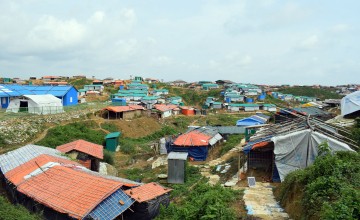
Thousands flee from Myanmar
In mid-August, reports began to emerge of forces making their way through Rohingya villages in Rakhine State, burning homes and attacking and killing civilians.
Hundreds of thousands of Rohingya began their journey to the Bangladesh border, risking their lives to reach the safety of another country.
“We walked for 16 days,” reveals Jaheda.
“The roads were full of checkpoints so we crawled in the jungle to save our lives. We hid in large trees, under water and in small caves. We ate leaves in the jungle and fed muddy water and leaves to the children.
“We had no fresh, clean water.
“We were eventually discovered just as we were crossing the river to Bangladesh. Thankfully, our children made it safely on their boat with the male family members, but I, along with my sister and mother, were shot at.”
The movement of Jaheda, her family and other members of the stateless Rohingya community would run into the hundreds, then the thousands, then the hundreds of thousands.
They would land on a long strip of land in Bangladesh close to Cox’s Bazar, home to the world’s longest beach and best known as a popular destination for honeymooning Bangladeshi couples and holidaymakers alike.
Cox’s Bazar and an ever-expanding camp
Jaheda, wounded by gunfire along with her sister and mother, somehow made it across the border to the ever-expanding camp.
Her father died in the unrest, shot dead.
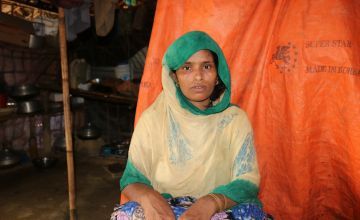
“I was hit before getting on the boat and my sister and mother were in the boat when they were shot – but we kept going.
“We had no other choice and there was no way back. When we got to the other side we met the rest of our family and ran to the hills to hide.
“We used herbs, grass and leaves to stop the bleeding. Eventually, some Bangladeshis found us and brought us to a makeshift camp. All of us were admitted to hospital.”
They would eventually recover and start their new lives in a two-room shelter along with Jaheda’s husband, four children, mother, sister, as well as her sister’s husband and three children.
To see 12 people sharing such a small space is not uncommon in the camps, which stretch as far as the eye can see once you finish a two-hour drive along the coast from the town of Cox’s Bazar itself.
Concern’s initial response to the crisis
"Concern were one of the first agencies to respond to the crisis because we had former staff members in the area, having worked on previous projects there,” says Lucia Ennis, Concern’s Regional Director for Asia.
“It was just basic response in meeting their immediate needs at the time, and then we had to appraise what we would do (in the longer term).
"When the international aid community went in, it scaled up very quickly. We did assessments and, considering our global experience in addressing malnutrition, we decided to set up a nutrition programme.

"Because people had left Myanmar so quickly, a lot of children were either born on arrival or born on the way, so there were huge issues with malnutrition and overcrowding."
Treating malnutrition in the camps
The majority of the Rohingya refugees currently reside in 34 extremely congested camps, where structures built from bamboo and tarpaulin house a majority of women and children.
Malnutrition rates remain a problem, particularly for young children. Concern operate a number of health centres (known as Outpatient Therapeutic Programmes or OTPs) across eight camps, where children under the age of five are screened for malnutrition.
If a child is found to be malnourished, they will be placed on a programme with a view to quickly restoring their health.
"The families can't afford good nutritious food and they're not able to plant easily, which is why we have the community gardens (where refugees learn how to grow their own food). Plus, we're doing food distribution with the World Food Programme."
The cure rate for treatment of children under the age of five with severe malnutrition at Concern's health centres is 97% on average, well above the Sphere Minimum Standards of Humanitarian Response rate of 75%.
Monsoon season in Bangladesh
Highly disruptive weather events are common in Bangladesh, particularly between April and November, and can create a further burden for the Rohingya people.
To prepare for the worst of monsoon season, when high winds can carry off bamboo, tarpaulin, wood and metal sheets and pose a serious threat to life, Concern works with partners to make the terrain more robust and maintain access at all times.
In 2018, Concern’s disaster risk mitigation measures also included the reinforcement and structural upgrades of six OTP centres, as well as the relocation of one centre to ensure all sites were cyclone-resistant and to alleviate flooding and landslide risks.
However, Jaheda knows better than most that the makeshift camp is not capable of dealing with the needs of such a large population.
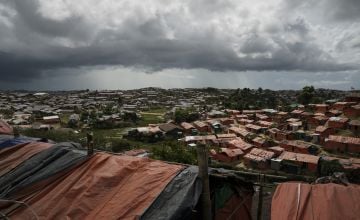
“The water supply and infrastructure is inadequate compared to the population in the camp,” she tells us.
“Reaching the bathrooms we share is difficult during rain. Most of the bamboo stairs and bridges, built to help us when the ground is very muddy, are weak.”
Integrating with the host community
Often forgotten in the swell of publicity around the Rohingya’s arrival in Cox’s Bazar, and the international community’s efforts to maintain their dignity and health in such difficult circumstances, is the host community of Bangladeshis in the area, whose lives have changed significantly since August 2017.
There are 500,000 Bangladeshis currently living in the two sub-districts of Cox’s Bazar where the Rohingya camps are based and, while they and the Bangladesh government have gone to great lengths to accommodate the influx, the impact is being felt as local resources go into the relief effort, prices of goods and services are driven up and labour becomes cheaper.
Concern is working with both the Rohingya and the host communities at present to ensure that the basic needs of all those living in the area are met.
"The big challenge in Cox's Bazar is acceptance from the local community."
“This was already a poor area, with little or no services there for the local community. There were no major hospitals or school facilities there, for example."
Respecting the local culture
She explains that beyond the tourism sector, there are limited opportunities for income in the Cox’s Bazar area as the land is not good for farming and there are few natural resources.
"Then the population multiplied by thousands, so the impact on resources and the environment have been a major challenge .
"Concern, from day one, always said we'd work with both the settled community and the people living in the camps
"We've got around 175 staff down there, but we've also got about 250 volunteers and those volunteers are either from the Rohingya community in the camps or from the local community. Most of our staff are Bangladeshi. We really want to look at the context and respect the local culture and tradition, as well as trying to meet the needs of the Rohingya and the community around them."
What does the future hold for the Rohingya?
A.K.M. Musha is Concern’s Country Director in Bangladesh, and he sees the strain that the situation is putting on the host community.
“There is huge socio-economic and environmental pressure resulting in increased tension between refugees and the host community,” he says.
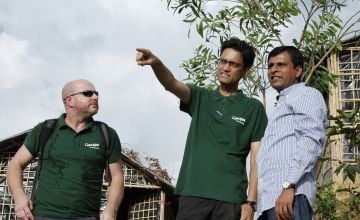
“The tensions will continue to increase unless the host communities are supported well. It's a difficult situation for all.”
Talks over the return of the Rohingya refugees to Myanmar have been taking place over the past two years, while there have also been reports that as many as 100,000 people could be moved to the remote island of Bhasan Char.
Guarantees over repatriation
Musha says a number of guarantees need to come from the Myanmar government before the possibility of going back can even be considered.
The authorities in Myanmar recently cleared just 3,540 people for repatriation, only for those chosen Rohingya refugees to opt against returning to Rakhine State without assurances over their future.
This week, Concern joined 60 other local, national and international NGOs in calling for human rights for all to be recognised in Rakhine State and for Rohingya refugees to have a role in deciding the course of their own lives, including conditions for their return to Myanmar.
They are also calling for the Rohingya to have full access to education, livelihoods and protection, and the identification of both medium and long-term solutions to the crisis.
“The Rohingya people don't believe the situation in Myanmar is currently conducive to repatriation. It would be very difficult for people to go back to Myanmar unless the situation improves there,” adds Musha.
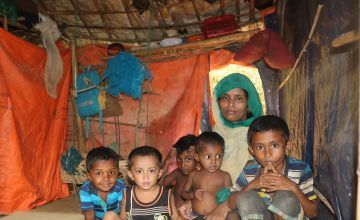
“We are still unclear whether this is going to happen. We are observing the situation. NGOs including Concern Worldwide are committed to providing lifesaving support and have urged the international community to put pressure on Myanmar to address the problem there and to support Bangladesh government to provide essential services and ensure the dignity and rights of the Rohingya people.”
Jaheda, for one, is worried about the prospect of returning to Myanmar, having found a far more settled life in Bangladesh.
“I am happy to see my children being happy,” she says.
“When I see them growing healthy and when I see my mother alive, I feel good. We have gone through so much trouble. I am happy that it has now ended. I have nothing left in my old home. I have my life and my children are much safer here. I don’t want to go back to Myanmar. I can’t tolerate seeing the place where I saw my father dying.”
*Jaheda’s name has been changed to protect her identity
Find out more about about our work in Bangladesh below
Our impact in 2024
people reached, in 27 of the world's most fragile places
people supported in 50 emergencies
people reached through our health and nutrition programmes


